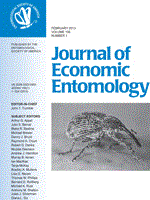Current bed bug, Cimex lectularius L., control usually involves insecticide applications that pose a high risk of insecticide exposure to residents and applicators. To minimize these risks and the amount of insecticides used, we designed and evaluated a dust band treatment technique. The laboratory assay showed that 1% cyfluthrin dust treated bands are highly effective in killing bed bugs. We further evaluated this technique in bed bug infested apartments. The “dust band” treatment consisted of installing a 3.8-cm-wide fabric band on furniture legs and brushing Tempo dust (1% cyfluthrin) (Bayer Environmental Science, Research Triangle Park, NC) onto the bands. In addition, interceptors were installed under furniture legs. Alpine (0.5% dinotefuran) aerosol spray was applied directly to live bed bugs found on furniture during biweekly inspections. This treatment was compared with two other treatments: “integrated pest management” (IPM) and “control.” The IPM treatment included dust bands plus the following: applying hot steam to infested furniture and surrounding areas, installing mattress encasements, applying 1% cyfluthrin dust around room perimeters, and installing interceptors under furniture legs. Alpine aerosol was applied to live bed bugs found during biweekly inspections. In the control group, the apartments received cursory treatment with insecticide sprays by the existing pest control contractor hired by the property management office. Bed bug numbers before and after treatments were determined based on biweekly interceptor counts or a combination of interceptor counts and visual inspections. From 0 to 12 wk, mean bed bug counts of the dust band, IPM, and the control treatment decreased by 95, 92, and 85%, respectively. Both dust band and IPM resulted in higher bed bug reduction than the control. There was no significant difference in the final counts between dust band and IPM treatments. An additional field experiment showed installing 1% cyfluthrin dust band and interceptors in lightly infested apartments prevented bed bug population rebound. Results indicate applying insecticide dust bands to furniture legs is an effective bed bug control technique.
How to translate text using browser tools
1 February 2013
Evaluation of an Insecticide Dust Band Treatment Method forControlling Bed Bugs
Changlu Wang,
Narinderpal Singh,
Richard Cooper,
Chaofeng Liu,
Grzegorz Buczkowski
ACCESS THE FULL ARTICLE
It is not available for individual sale.
This article is only available to subscribers.
It is not available for individual sale.
It is not available for individual sale.
bed bug
Cimex lectularius
control
dust
infestation





